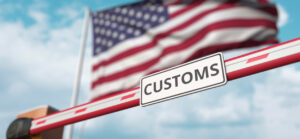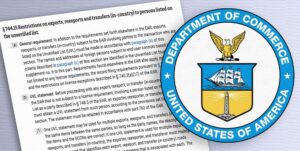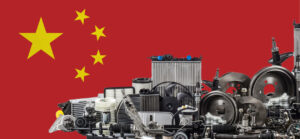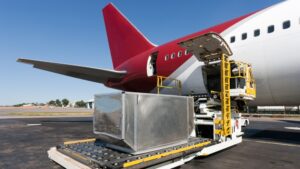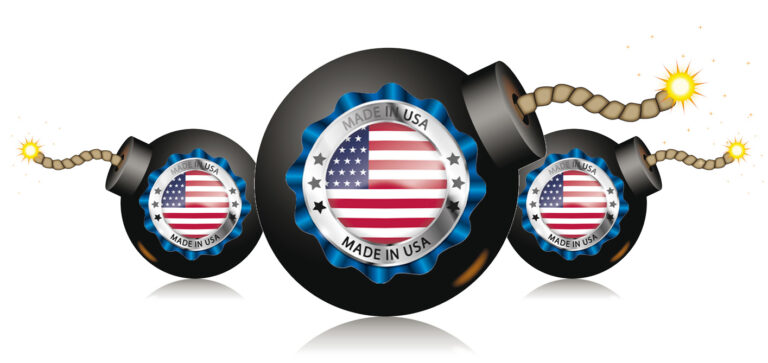
Determining when a product can be labeled or advertised as Made in America is an ongoing compliance challenge.
One seeming gray area arises when a product which undergoes production activities in the U.S. is no longer an article of foreign origin falling under CBP’s oversight. If it undergoes a substantial transformation in the United States, it is no longer considered to have foreign origin under CBP’s rules. This does not mean, however, that it can now be labeled as Made in America. Instead, the Federal Trade Commission’s very different standard will apply for that determination.
The Federal Trade Commission requires that “for a product to be called Made in USA, or claimed to be of domestic origin without qualifications or limits on the claim, the product must be ‘all or virtually all’ made in the U.S.”
To make what the FTC calls an unqualified claim, that is, one which includes no reference to foreign content, the FTC requires three things:
- First, the final assembly or processing of the product must occur in the United States.
- Second, all significant processing that goes into the product occurs in the United States.
- And third, all or virtually all ingredients or components of the product are made and sourced in the United States.
Unfortunately, there is no bright line to tell us when a product or process meets these criteria. A person making either a qualified or unqualified claim is expected to have a good-faith basis for concluding it meets the FTC’s standards and to maintain records regarding the content and processing of its products.
The Federal Trade Commission takes a very dim view of mislabeled foreign-made products, as demonstrated in two enforcement actions.
The most recent case involved a company which markets clothing accessories, such as belts and wallets. It made unqualified claims that the products were made in the USA, even though some of the products were actually imported and others had substantial foreign content.
The FTC was not amused, however, and has proposed a consent agreement under which the company will no longer make misleading origin claims and has agreed to pay a judgment of over $191,000.
The second case involved parts and equipment for motorcycles, motocrosses and all-terrain vehicles. The vendor claimed its goods were “Made in the USA” or even “Proudly Made in the USA.” According to the FTC, though, the products were either made entirely abroad or, if produced in the U.S., had substantial foreign content. The FTC alleged that some merchandise was imported already labeled as Made in United States, an apparent violation of both CBP and FTC requirements.
This case was resolved with the vendor agreeing to an injunction against future violations as well as a monetary judgment of more than $872,000.
As these cases illustrate, the Federal Trade Commission will aggressively pursue claimed violations, particularly when they involve mislabeled foreign-made products.
Watch as George Thompson, international trade attorney, discusses FTC requirements for “Made in USA” labeling.
Thompson & Associates, PLLC provides representation in all aspects of customs laws and regulations, specializing in export and import regulations and international business counseling. We can be reached at 202-772-2039 or online.
Transcript of "The 'Made in America' Minefield"
Good afternoon. This is George Thompson. And today we’ll cover a topic that never seems to get old – when can a product be labeled or advertised as Made in America?
In the first half of this year, already there have been three Federal Trade Commission enforcement actions against companies that didn’t understand the rules, or at least didn’t follow them, so it’s an ongoing compliance challenge.
With the government’s established policy preference for domestically made products, I expect we will be seeing more misunderstandings as companies move production activities to the United States. So, I thought a brief review would be timely.
Jurisdiction over claims that articles are made in America, or made in USA, is given by statute to the Federal Trade Commission. By contrast, Customs and Border Protection is responsible for enforcing the country of origin marking rules which apply to articles of foreign origin.
One seeming gray area arises when a product which undergoes production activities in the U.S. is no longer an article of foreign origin falling under CBP’s oversight. If it undergoes a substantial transformation in the United States it is no longer considered to have foreign origin under CBP’s rules. This does not mean, however, that it can now be labeled as Made in America. Instead, the Federal Trade Commission’s very different standard will apply for that determination.
To make what the FTC calls an unqualified claim like this, that is, one which includes no reference to foreign content, the FTC requires three things:
- First, the final assembly or processing of the product must occur in the United States.
- Second, all significant processing that goes into the product occurs in the United States.
- And third, all or virtually all ingredients or components of the product are made and sourced in the United States.
Therefore, a product with more than a small amount of foreign content, by importance as well as by value, will not meet this standard. Calling it “Made in America” is, in the FTC’s view, false and misleading to consumers.
The agency does allow use of qualified claims for products which are manufactured or assembled in the United States with foreign content. Statements that an article was made in this country must be accompanied by an immediately adjacent qualification that accurately conveys the extent to which the product contains foreign parts, ingredients, or components, as well as processing.
Claims that a product is assembled in the United States are permissible only if that product is last substantially transformed in the U.S., its principal assembly takes place here, and the U.S. assembly operations are substantial.
Unfortunately, there is no bright line to tell us when a product or process meets these criteria. A person making either a qualified or unqualified claim is expected to have a good-faith basis for concluding that it meets the FTC’s standards and to maintain records regarding the content and processing of its products.
While there is some room for subjectivity as to whether a particular product meets the requirements, the FTC enforcement cases I mentioned at the outset show pretty serious disregard for compliance.
The most recent one involved a company which markets clothing accessories, such as belts and wallets. It made unqualified claims that the products were made in USA, even though some of the products were actually imported and others had substantial foreign content.
In one particularly amusing example, the company “imported belt straps from Taiwan, attached buckles to the straps in the United States, and labeled the finished products as ‘Made in USA from Global Materials’.”
The FTC was not amused, however, and has proposed a consent agreement under which the company will no longer make misleading origin claims and has agreed to pay a judgment of over $191,000.
The second case involved parts and equipment for motorcycles, motocrosses and all-terrain vehicles. The vendor claimed its goods were “Made in the USA” or even “Proudly Made in the USA.” According to the FTC, though, the products were either made entirely abroad or, if produced in the U.S., had substantial foreign content. The FTC alleged that some merchandise was imported already labeled as Made in United States, an apparent violation of both CBP and FTC requirements.
This case was resolved with the vendor agreeing to an injunction against future violations as well as a monetary judgment of more than $872,000.
As these cases illustrate, the Federal Trade Commission will aggressively pursue claimed violations, particularly when they involve mislabeled foreign-made products.
Now, come on, claiming an imported product was made in the United States is inexcusable. The more difficult situation involves U.S. made items with foreign content. This requires a company planning to make an origin statement to be aware of the “all or almost all rule” as well as the guidelines for making qualified or unqualified claims.
As an epilogue, it may be useful to contrast the requirements to qualify a product for federal Buy American procurement with the FTC Made in USA labeling provisions.
To be a United States end product under the Federal Acquisition Regulation, an article most both be manufactured in the U.S. and have U.S. origin components accounting for at least 60 percent of its value. While such a product may get a domestic preference for federal government procurement purposes, it may not pass muster under the FTC labeling rules.
Thanks for tuning in. Links to the FTC cases that I mentioned are going to be included in the blog that will accompany this video.
Thompson & Associates, PLLC provides representation in all aspects of customs laws and regulations, specializing in export and import regulations and international business counseling. We can be reached at 202-772-2039 or online.

